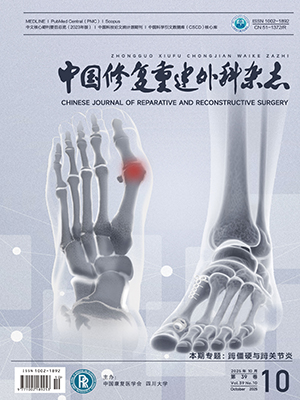Objective To compare the biomechanical properties of personalized Y-shaped plates with horizontal plates, vertical plates, and traditional Y-shaped plates in the treatment of distal humeral intra-articular fractures through finite element analysis, and to evaluate their potential for clinical application. Methods The study selected a 38-year-old male volunteer and obtained a three-dimensional model of the humerus by scanning his upper limbs using a 64-slice spiral CT. Four types of fracture-internal fixation models were constructed using Mimics 19.0, Geomagic Wrap 2017, Creo 6.0, and other software: horizontal plates, vertical plates, traditional Y-shaped plate, and personalized Y-shaped plate. The models were then meshed using Hypermesh 14.0 software, and material properties and boundary conditions were defined in Abaqus 6.14 software. AnyBody 7.3 software was used to simulate elbow flexion and extension movements, calculate muscle strength, joint forces, and load torques, and compare the peak stress and maximum displacement of the four fixation methods at different motion angles (10°, 30°, 50°, 70°, 90°, 110°, 130°, 150°) during elbow flexion and extension. Results Under dynamic loading during elbow flexion and extension, the personalized Y-shaped plate exhibits significant biomechanical advantages. During elbow flexion, the peak internal fixation stress of the personalized Y-shaped plate was (28.8±0.9) MPa, which was significantly lower than that of the horizontal plates, vertical plates, and traditional Y-shaped plate (P<0.05). During elbow extension, the peak internal fixation stress of the personalized Y-shaped plate was (18.1±1.6) MPa, which was lower than those of the other three models, with significant differences when compared with horizontal plates and vertical plates (P<0.05). Regarding the peak humeral stress, the personalized Y-shaped plate model showed mean values of (10.9±0.8) and (13.1±1.4) MPa during elbow flexion and extension, respectively, which were significantly lower than those of the other three models (P<0.05). Displacement analysis showed that the maximum displacement of the humerus with the personalized Y-shaped plate during elbow flexion was (2.03±0.08) mm, slightly higher than that of the horizontal plates, but significantly lower than that of the vertical plates, showing significant differences (P<0.05). During elbow extension, the maximum displacement of the humerus with the personalized Y-shaped plate was (1.93±0.13) mm, which was lower than that of the other three models, with significant differences when compared with vertical plates and traditional Y-shaped plates (P<0.05). Stress contour analysis showed that the stress of the personalized Y-shaped plate was primarily concentrated at the bifurcation of the Y-shaped structure. Displacement contour analysis showed that the personalized Y-shaped plate effectively controlled the displacement of the distal humerus during both flexion and extension, demonstrating excellent stability. Conclusion The personalized Y-shaped plate demonstrates excellent biomechanical performance in the treatment of distal humeral intra-articular fractures, with lower stress and displacement, providing more stable fixation effects.
Citation:
YU Hao, PENG Jiachen, YANG Jibin, YANG Lidan, XU Zhi, YANG Chen. Biomechanical advantages of personalized Y-shaped plates in treatment of distal humeral intra-articular fractures. Chinese Journal of Reparative and Reconstructive Surgery, 2025, 39(5): 574-583. doi: 10.7507/1002-1892.202503066
Copy
Copyright © the editorial department of Chinese Journal of Reparative and Reconstructive Surgery of West China Medical Publisher. All rights reserved




